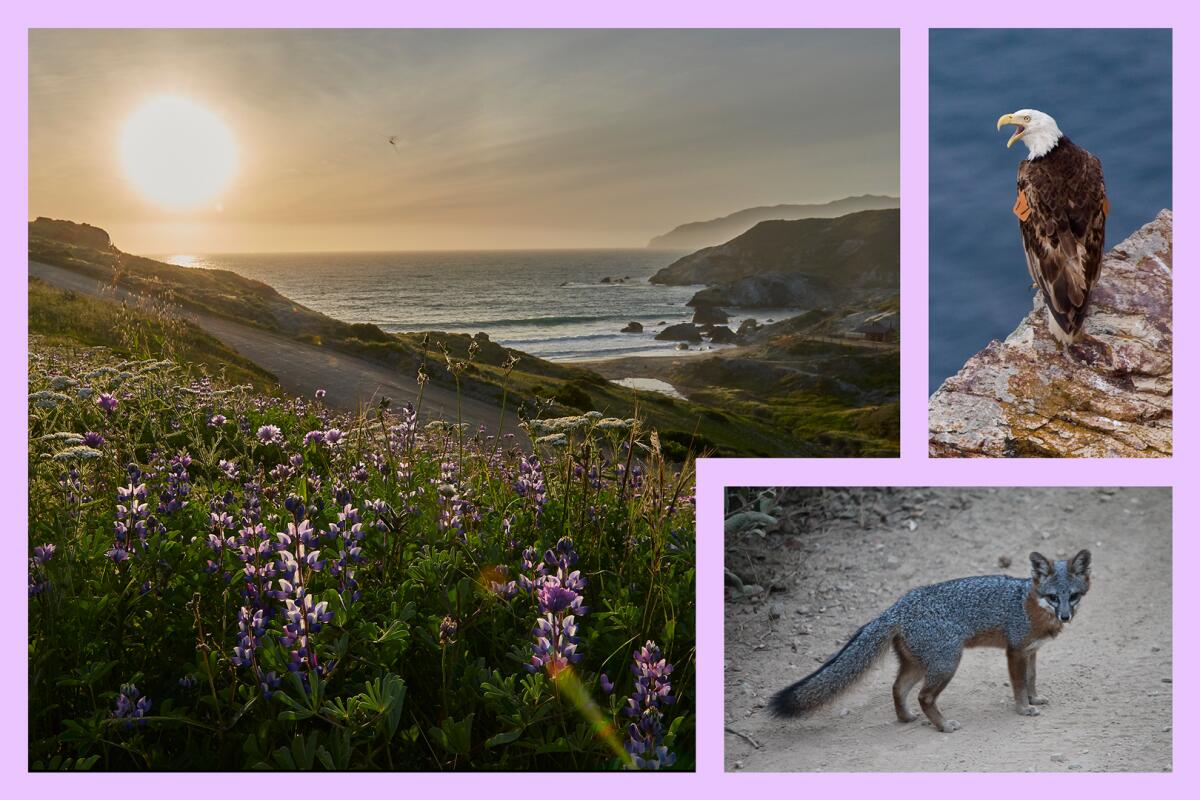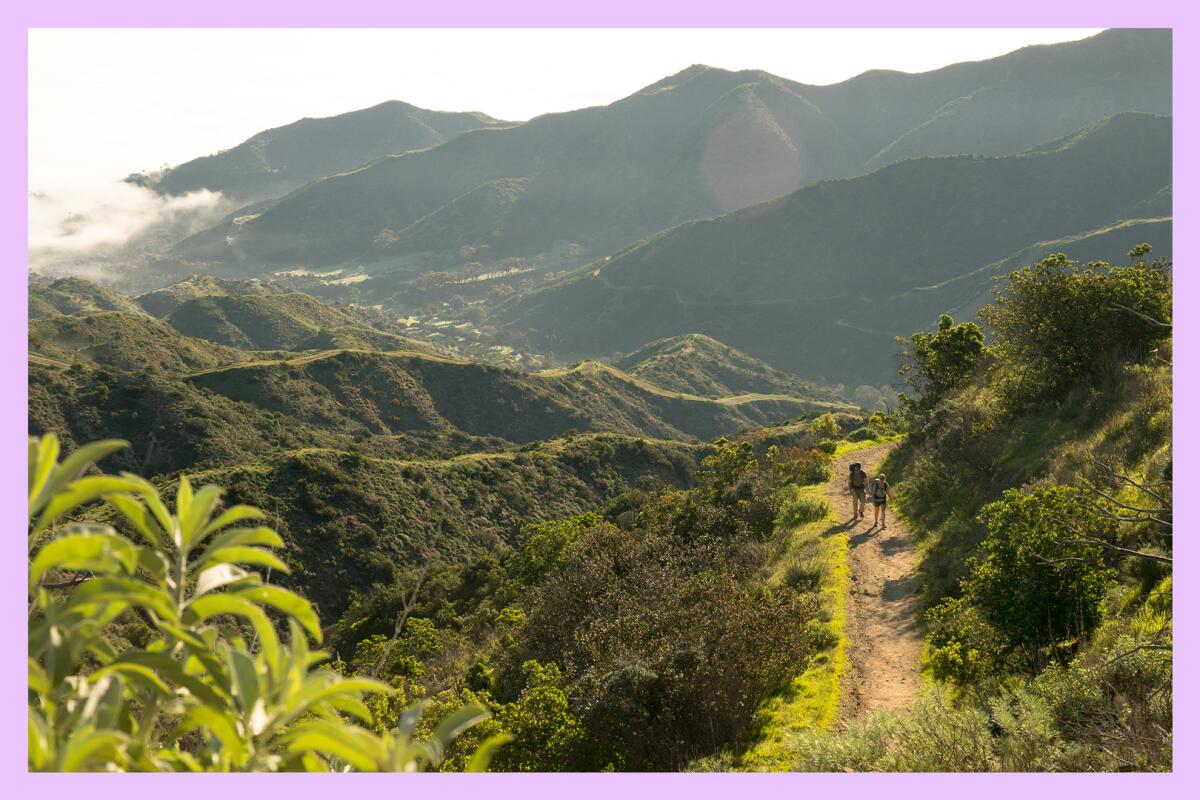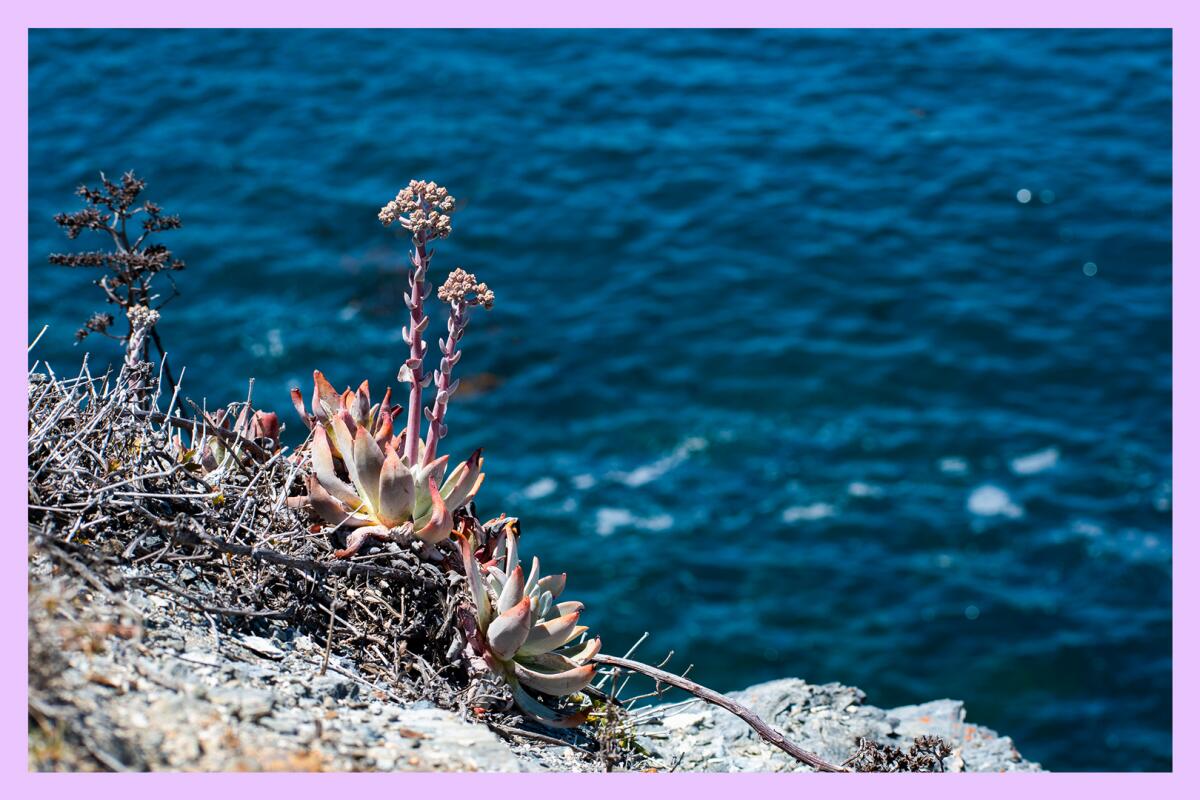Mingle with foxes and soak in ocean views on this under-the-radar Catalina Island hike

- Share via
Of the eight Channel Islands flanking our Southern California coast, it’s the northern ones, like Santa Cruz and Anacapa Island, that get the most attention from adventurous hikers. But there’s a southern Channel Island much closer to us, and more easily accessible from our ports: Catalina Island.
Though it has an ideal four-day thru-hiking trail, the Trans-Catalina Trail, few Catalina Island visitors I’ve spoken to have hiked it. Maybe it’s the steep single tracks or the lack of sun protection from trees, which can make it feel less “friendly,” especially during the summer. That’s too bad, because the hike offers scenic beach camping, stunning ocean views and unique plants and animals.

Mostly known as a tourist destination, Catalina Island is a 76-square-mile island with approximately 4,000 year-round residents and a vintage, small-town feel in its major port city, Avalon. Easily walkable (or driveable in a golf cart, since few cars are allowed), its streets are lined with quaint Victorian houses. Avalon hosts summer camps for kids and is a quick weekend escape for Angelenos, as well as a popular Fourth of July celebration spot. Developed by William Wrigley Jr. of the Wrigley chewing gum family in the 1920s, Avalon underwent a major renovation and expansion starting in 2014. In 2016, the renovated Catalina Island Museum opened.
My family took the one-hour, high-speed Catalina Express ferry ride from Long Beach to Avalon in the height of summer last year to experience the town’s easy tourist delights. The ride itself feels elegant and romantic; the sea was smooth as glass. (There are also departure ports from San Pedro and Dana Point.) We stayed at a charming new-ish boutique spot, the Bellanca Hotel. We sunned ourselves at the Descanso Beach Club, rented a golf cart to ride high into the hills, then plunged into the ocean to see fish on a submersible tour. We woke up to decadent French toast at the Naughty Fox (the island is known for mischievous foxes) and ate too much (is that possible?) arrabbiata at M Restaurant.
When my son woke at the crack of dawn every morning, I sleepily strolled him to Scoops Homemade Ice Cream for fresh banana nut muffins, and then took him to play at the Knabe pirate playground, a ship-themed playground I wished I could duplicate in my hometown. We took beautiful walks with our travel stroller, but at the time our son was too young to hike the Trans-Catalina Trail.
Get The Wild newsletter.
The essential weekly guide to enjoying the outdoors in Southern California. Insider tips on the best of our beaches, trails, parks, deserts, forests and mountains.
You may occasionally receive promotional content from the Los Angeles Times.
You know I’m always itching to take my preschooler on more hikes, and I’ve written about how to motivate kids to hike farther. Curious about how family-friendly the thru-hike was, I dialed up Gina Nelson, director of membership and marketing at the Catalina Island Conservancy, a private land trust that protects 88% of Catalina Island’s approximately 48,000 acres, including maintenance of 165 miles of roads and trails and conservation of its more than 60 unique endemic species of plants and animals.
Every year, 300,000 annual visitors come to see the wilder side of Catalina, and at least a portion of them do its “mini thru-hike,” the 38.5-mile Trans-Catalina Trail. The hike through coastal shrublands with stunning views of the ocean takes about four days, with three nights at three different campsites: Black Jack, Two Harbors and Parsons Landing. Depending on your experience, you may find the at-times steep trails and length challenging, or you may consider the 1,745-foot elevation moderate. (On that note, spoiler alert: The steep hike is not toddler-friendly, even for our rugged Thule Urban Glide jogging stroller, but your adventurous teenager might enjoy it as prep for longer hikes like the Pacific Crest Trail.) Either way, it’s the perfect training ground for longer hikes.

“You get a great sense of accomplishment by finishing the 38 and a half miles,” Nelson told me. “Along the way, you experience these great heights each day, almost up to 2,000 feet, with amazing vistas off the leeward side.”
You’ll see the Palos Verdes peninsula and the port of Long Beach, and from the windward side of Catalina you may spy the other Channel Islands on a clear day. All three Conservancy campsites offer such amenities as drinking water and toilets, but at Parsons Landing campers must request water to be dropped off for them (reserve spots early, as they fill up quickly. Conservancy members get 50% off bookings). Mary Forgione’s guide to hiking the Trans-Catalina Trail has even more details.
Nelson advises stocking your hiking pack with layers for the alternating fog, sun and sea breezes, plus as much water as you can carry comfortably, a sleeping bag, hiking poles, cooking gear (ultralight, if possible), food and sun protection including a hat, sunscreen and UPF clothing. Of course, wear your hiking boots. If you’d rather not haul your pack full of food and drink, Catalina Backcountry can carry up to 50 pounds of supplies for you to each campground for a fee of anywhere from $175 for Avalon to Black Jack Campground to $1,605 for the full trail. This is especially great for trail runners, younger hikers or beginner backpackers.

Since the interior of the island can be 20 degrees warmer than the beach and the trail offers no shade, Nelson recommends that novices do the hike in cooler months. If you’d like to join a group, every spring the conservancy hosts the BZ Jones Cross-Catalina Hike.
Whenever you visit the island, don’t miss the opportunity to learn about its unique flora and fauna. You may see a unique Catalina fox, bison and two endemic species: a supersized ground squirrel 30% larger than its mainland cousin and the Catalina California quail, according to Catalina Island Conservancy Wildlife Manager Makenzie Henk.
Plantwise, look for the Catalina Island cherry, which can grow three to four times higher than the native mainland cherry. Catalina Island Conservancy rare plant ecologist Kevin Alison says you’ll see island gigantism in many native plants across the island, such as Saint Catherine’s Lace, island oak and feltleaf ceanothus. “With abundant fog, no native browsing or grazing animals plus available niches, certain plants evolved to be giants compared to their relatives on the mainland,” he says.

Keep an eye out for the the Dudleya virens ssp. insularis, nicknamed the “live-forever” for its ability to survive for many decades despite long periods of drought. This coastal bluff plant helps prevent erosion. The local island Dudleya is an important food source for hummingbirds, native bees and butterflies, including Catalina’s endemic Avalon scrub-hairstreak. According to Alison, although Dudleya naturally occur along the western coast from southern Oregon to Baja California, the island species are exceptionally rare, with a few included on the endangered species list. In California, poaching the imperiled Dudleya comes with a $5,000 fine per plant. Catalina Island Conservancy Rangers recently caught poachers in the act of removing several mature Dudleya, the largest of which was several decades old; the succulents were salvaged and will be transplanted back onto the landscape.
With other challenges caused by recent rains, including washed-out trails, rockslides and road blockages as well as overgrowth of invasive nonnative annual grasses, the conservancy crew has been hard at work. But most trails are now open to visitors, so it’s a great time to visit Catalina Island. “Once you get into the interior of the island and the wildland and see the amazing species we’re caring for, the amazing vistas from the top of these big hill climbs, it’s such a rewarding experience,” says Nelson.
Start prepping now for a beautifully Mediterranean-climate fall hike on the Trans-Catalina Trail by doing L.A. hikes of seven to 10 miles with a heavier pack. Or, if you’re a sun-seeker and experienced hot-weather hiker, summer might just be the perfect time for you to tackle the Trans-Catalina Trail.
3 things to do

1. Step, whirl and twirl in the warm summer air. The Music Center’s free summer Dance DTLA series happens every Friday from 7 to 11 p.m. starting June 23 and ending August 18 in Jerry Moss Plaza. Mark your calendar for nine consecutive Fridays of free, in-person, beginner dance lessons, starting with hip-hop on June 23, with easy-to-follow steps and no dance experience necessary. RSVPs are not required, but you can let the organizers know you’re coming if you like.

2. Tour the other kind of stars. Tool up to Griffith Observatory by driving or night hiking your way up the hill, where every month a free public “star party” takes place. From 2 to 9:45 p.m. on May 27 and June 24, you’ll get to try out the observatory telescopes to spy on the cosmic happenings of the sun, the moon, visible planets in our solar system and, of course, stars. Volunteers from the Los Angeles Astronomical Society, the Los Angeles Sidewalk Astronomers and the Planetary Society will be on hand to help out, as will amateur astronomers who can discuss the finer points of our heavenly bodies. Lines for each telescope cut off at 9:45 p.m.

3. Run to the top. Link up with Trials of Miles on June 1 from 4 to 6 p.m. in Griffith Park for the third stage in the four-stage Los Angeles Mountain Running Series, a trail running series taking place over several months across the city’s parks and trail systems. Stage three is a haul to the top of Mt. Hollywood via the scenic Hogback Trail. The steep hill will test your willpower, so get your practice runs in beforehand if possible. HOKA will provide demo trail running shoes, and REI will be giving away some freebies. Afterward, there will be nonalcoholic beers by Athletic Brewing Co. There’s no charge, but runners who want their names on the leaderboard or to be eligible for prizes should sign up here. The fourth and final stage of the series will be July 15 at Mt. Baldy and features “an epic Saturday night 5K.”
The must-read

The New York Times sent two New York-based photographers on a California road trip documenting the superbloom, and posted on Instagram with some of the photographers’ results on April 18. Wildflower-savvy commenters were quick to point out that several flowers pictured were not marvelous beauties we celebrate, but rather dangerous invasives we regularly spot on our hikes (and if they’re edible like black mustard, perhaps try to pull out by the root and eat).
“Just FYI: Frame 2 is NOT a California native plant, it is [a] highly invasive cape marigold. This plant overwhelms on sunny, native slopes and wipes out the biodiversity of the site in the process,” @WildyardsProject responded.
The comments gave context to what could be seen as just a sweeping landscape of flowers. After all, many Angelenos consider ID‘ing plants their hiking hobby, and know all too well the dangers that cape marigolds, pepperweed, African daisies and black mustard.
Calling invasive plants native wildflowers “confuses the many people who come to live in California that do not know our indigenous plants • Orange and yellow African daisy rapidly colonize space that could be poppy flowers • Black mustard fumigates the soil into lifeless dirt,” @rosethicket wrote.
Other respondents were more blunt, like @fullbloomflowerfarm: “Come New York Times. Write an article about how native flowers were and are the food source for people for hundreds of years or you know, post mustard photos. If we don’t know how to identify native plants, how are we to respect them?”
As Susan Wittig Albert put it in “An Unthymely Death and Other Garden Mysteries”: “One person’s weed is another person’s wildflower” — but these are some we’d rather not have around, especially when fire season rolls around in the fall.
Happy hiking while rooting up invasives,

P.S.

Is it outdoor film season yet? I’ve got my Nemo Victory picnic blanket, Corsickle Sport Canteen for dumping a bottle of wine into and my heart set on purchasing a new set of bike picnic panniers (got any recs?). My summer solstice dream is to screen a film from the top of a mountain or inside a high-up canyon treehouse with my friends, passing around gourmet picnic dishes, including grilled lotus root and this crunchy and spicy green potato salad from our resident cooking columnist, Ben Mims. And of course, Genevieve Ko’s PB&J sandwich cookies for dessert. We’ll need the fuel for the night hike down the hill, right?
For more insider tips on Southern California’s beaches, trails and parks, check out past editions of The Wild. And to view this newsletter in your browser, click here.
Sign up for The Wild
We’ll help you find the best places to hike, bike and run, as well as the perfect silent spots for meditation and yoga.
You may occasionally receive promotional content from the Los Angeles Times.




